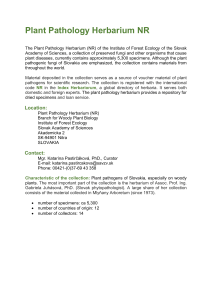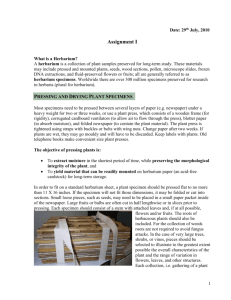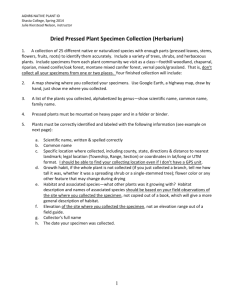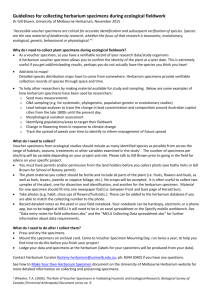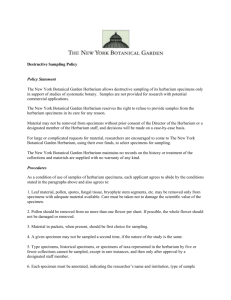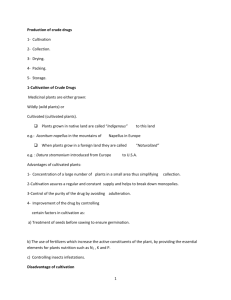2. Country(ies) involved
advertisement
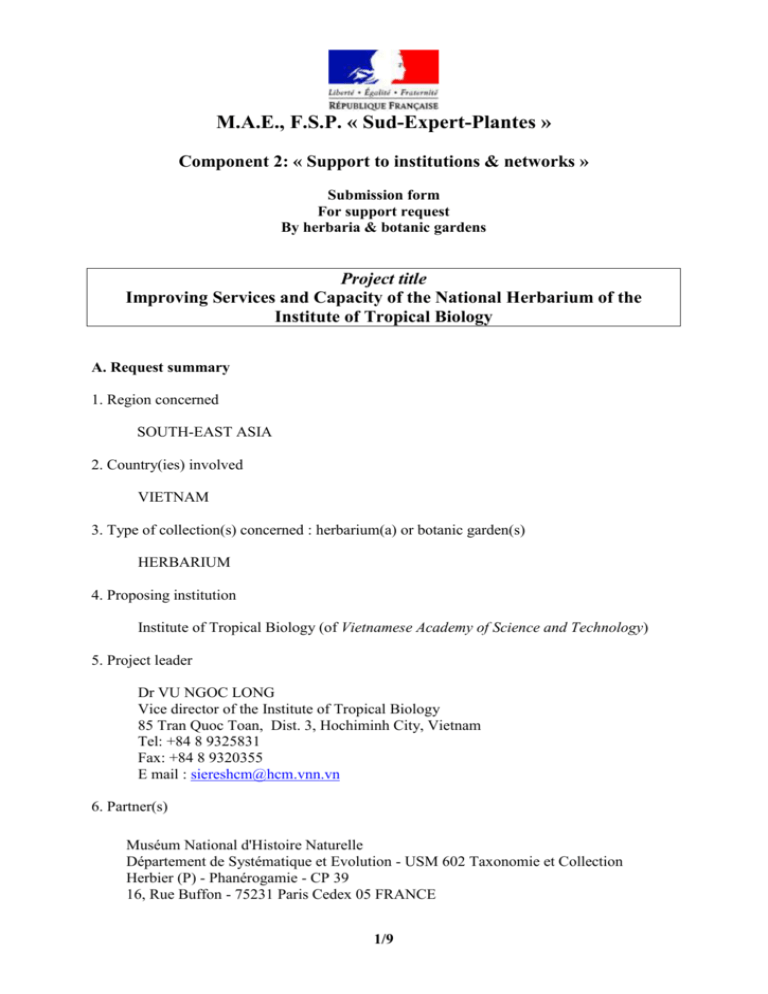
M.A.E., F.S.P. « Sud-Expert-Plantes » Component 2: « Support to institutions & networks » Submission form For support request By herbaria & botanic gardens Project title Improving Services and Capacity of the National Herbarium of the Institute of Tropical Biology A. Request summary 1. Region concerned SOUTH-EAST ASIA 2. Country(ies) involved VIETNAM 3. Type of collection(s) concerned : herbarium(a) or botanic garden(s) HERBARIUM 4. Proposing institution Institute of Tropical Biology (of Vietnamese Academy of Science and Technology) 5. Project leader Dr VU NGOC LONG Vice director of the Institute of Tropical Biology 85 Tran Quoc Toan, Dist. 3, Hochiminh City, Vietnam Tel: +84 8 9325831 Fax: +84 8 9320355 E mail : siereshcm@hcm.vnn.vn 6. Partner(s) Muséum National d'Histoire Naturelle Département de Systématique et Evolution - USM 602 Taxonomie et Collection Herbier (P) - Phanérogamie - CP 39 16, Rue Buffon - 75231 Paris Cedex 05 FRANCE 1/9 Contact person: Dr. Sovanmoly HUL Editor-in-Chief of the "Flore du Cambodge, du Laos et du Viêtnam" Curator of Asian Collections of Paris Herbarium Tel: 00.33.(0)1.40.79.33.57, Fax: 00.33.(0)1.40.79.33.42 7. Dimensions of the collection(s) concerned Managed by the Institute of Tropical Biology (ITB) in Hochiminh City, the Herbarium of Vietnam is a symbol for scientific cooperation between France and Vietnam for long time. It is considered as a scientific patrimony of different plant collections all over Indochina and from other parts of Asia: China, Malaysia, Hongkong, Philippines, Indonesia, Japan, Singapore. The Herbarium was created more than 100 years ago. Firstly the Herbarium was under the “Institut scientifique de l’Indochine”. In 1954 it was passed to the Institute of Agronomic Research (Saigon). From the period of 1978 to 1993, it was under the management of the CNRS Vietnam. And from then ITB has been being responsible for managing the herbarium. There are presently some 80,000 vascular plant samples (10,000 species) stored at the herbarium, of which some 40,000 are not yet identified. Most of samples (60,000 samples) were collected within the period of 1861 to 1954 in the peninsula of Indochina by the French botanists, e.g. Thorel, Harmand, Pierre and Bon (till the end of the 19th century) and Poilane, Pételot, Chevalier and Eberhardt (in the 20th century). It was used as the basis for composing the famous “ Flore Générale de l’Indochine”. Almost 20,000 samples collected by Pételot and Poilane have not been determined yet. Before 1975, some of them were sent to the Muséum of Paris for identification. ITB has contributed to the herbarium through collections from the Central Highlands, Bu Gia Map, Logo Xamat,… within different projects. About 200 – 300 samples were added to the herbarium per year. The Herbarium holds some types crucial for reference studies. 200 types have been registered and much more efforts awaits. Beside the plant samples, a collection of books with 1,000 items is stored at the herbarium. Although modern taxonomical books are not diverse, some of available books are of antique value, for example: Horti rarorium plantarum (Comelino J. 1697), Classes plantarum (Linné C.A. 1738), Flora cochinchinensis (Loureiro 1790). 8. Project duration 3 YEARS. 9. Total budget (in Euros) € 43,000. 10. Funding sources In cash: From SEP: € 40,000. From ITB: € 3,000. 2/9 In kind: From ITB : Identification of plants (equal to € 2,000) 11. Amount of the contribution requested from Sud Expert Plantes (in Euros) € 40,000. B. Project description 1. Context and rationale In southern Vietnam, ITB is emerging as a leading institution in the field of plant research and biodiversity conservation. The ITB has made contacts with many international and national organizations working on biodiversity conservation in Vietnam, namely, World Wildlife Fund for Nature (WWF), Fauna and Flora International (FFI), World Conservation Union (IUCN), Forest Inventory and Planning Institute (FIPI), Institute of Ecology and Biological Resources (IEBR), Missouri Botanical Garden, etc.. In the Lower Mekong region, beside its own projects, the staff of the ITB were contracted to be mainly responsible for coordinating or conducting components of projects on plant resources, biodiversity conservation, community development and environment education sponsored by international conservation organizations. The research and technical capacity that ITB has built through these projects brings us to the forefront of biodiversity conservation and sustainable development in southern Vietnam. However, the experience and capacity of the ITB needs to be further strengthened and shared with other partners, including national and grass-root organizations, for conserving and sustainably managing Vietnam’s rich biodiversity. This project is a great opportunity to build human and institutional capacity institutional and human resource capacity of the national herbarium managed by the ITB to meet present and future demands in plant research in Vietnam. Used as a crucial basis for diverse scientific researches related to the flora of Vietnam for more than 100 years, it is now that the herbarium urgently needs to be more invested in order to improve its storaging conditions and to conserve it against degradation. There is an urgent need for ITB to improve its services and scientific and technical capacity, to disseminate existing biodiversity data, and to link the database stored at the herbarium to the world community of plant researchers. Building capacity to promote the effective operation of this national herbarium of the Institute of Tropical Biology is essential to ensure its long-term outcomes. Current resources are inadequate to address required needs in operation of the national herbarium. Up to now, the lack of appropriate conserving – operating techniques and manpower has made the herbarium be open for visiting senior researchers only and not for university students and the larger public. Every year the herbarium facilitates about one hundred visiting researchers. Meanwhile, many international and national experts working on plant and biodiversity conservation in Vietnam are not based in Hochiminh City. Their access to the herbarium is in general costly. The services of the herbarium need reforming through exchange projects with other herbaria and accessibility to the internet in order to joint the Global Biodiversity Information Facility. The linkage of the herbarium’s database to be built through this project to the web will provide worldwide users with easy searching for and accessibility to specimen images and concomitant data that have been accessible via specimen labels and internal paper documents. This will facilitate and promote studies in floristics and plant taxonomy of Vietnam and 3/9 neighbor areas. Furthermore, electronic access will help reduce handling and therefore contribute to the conservation of specimens. In addition, more than 40,000 samples collected and stored at the herbarium need to be identified. Many researchers have expressed their willingness to provide their collections to store permanently at the herbarium. Therefore, the capacity of staff of the herbarium should also be built up in terms of operating, conserving samples and researching to meet the present and future demands of studies in plants of Vietnam and neighbor areas. In this project, ITB will cooperate with Muséum National d'Histoire Naturelle – a French partner which has experienced most of greatest studies and cooperation in plants of Vietnam and Indochina, including those stored at the Vietnamese herbarium. The involvement of the French partner will contribute to the management of the Vietnamese herbarium, including examination of the herbarium, training of personal in Vietnam and Paris and design of a software to digitalize samples. In addition, the French partner will share their web-accessible computerized database, cooperate in identification of specimens, host study visits of Vietnamese in France and help in setting up a programme to detect and digitalize types from Hochiminh City and Paris. Two French experts are expected to take part in this project: - - Dr. Sovanmoly HUL Editor-in-Chief of the "Flore du Cambodge, du Curator of Asian Collections of Paris Herbarium Laos et du Viêtnam" Mr. Marc PIGNAL Responsible for the Herbarium of Paris Curator of the Paris Herbarium 2. Objectives This proposed project is aimed at the following objectives: 2.1. To upgrade the operation, conservation and management of the herbarium. 2.2. To provide a worldwide-accessible database through connection of the herbarium to the world through GBIF system. 2.3. To promote activities in identification/taxonomy/research of plants of Vietnam and neighboring areas. 3. Activities To achieve the above objectives, the project will be implemented through the following activities: Checking, disinfection, mounting and arranging/storing specimens at herbarium This field of activities is aimed to improve operating and sample-storing conditions of the herbarium. The whole herbarium will be reordered after checking the present status of total specimens stored. Disordered/damaged specimens and labels will be subject for reparation/corrections. Specimens will be disinfected if needed. All repaired specimens will be mounted and labelled. The storing conditions of specimens will be upgraded by setting up an air-conditioning system. Supplies (furniture) for the assembly of the specimens will be required. A heater 4/9 for drying specimens will be equipped. The SEP project is expected to fund for the required equipment and chemicals. This activity field will be carried out by six experienced staff of ITB and four contracted staff. One more contracted person, in addition to the three present contacted staff will be recruited. All 80,000 specimens, including those processed above, will be arranged in a better accessible and safer manner. Of them, about 5,000 specimens will be disinfected and 2,000 mounted for long-term storage. This activity field is expected to be implemented in the first year of the project. Identification of specimens at herbarium Two collections of plants, one of which is from the limestone areas of the Vietnamese Mekong Delta and the other from the semi-arid coastal southern central Vietnam, will be identified by five researchers of ITB within this project. The total number of collected specimens is 600. This work will be done in the last two years of the project. Digitalization and computerization of collections, following existing norm In the first year of the project, two senior staff of the herbarium will take an about ten-day study visit to Europe (French partner: Muséum National d'Histoire Naturelle) to discuss on detailed cooperation (including possiblity to transfer specimens from France to Vietnam) and to learn the experience in structuring and operating techniques of and in linking the French herbarium to the GBIF. Lessons learned from this visit will be considered to apply for the Vietnamese herbarium. In the last two years of the project, the construction of the database will be started in the Vietnamese herbarium following the formatting standards of GBIF, including digitalizing the specimens, since the beginning of the second year. To prepare for digitalizing the database, a website with a software will be designed for storing and using the input database. The website should include a searching tool to help find out desired information quickly. A staff of the herbarium will be trained in relevant information techniques to facilitate and maintain the operation of the website. The best specimen of a species is subject for scanning/photograph. The information on the herbarium and its specimens on the website will be stored in a server which serves as a node to GBIF. An experienced researcher from the French partner will take a two-week visit to the Vietnamese herbarium to provide advices/further training for this activity domain. Two contracted technicians will be responsible for scanning/photographing the specimens. Two other staff will be responsible for inputting the botanical data into the computer under supervision/checking by two experienced researchers of ITB. From the budget of the SEP project, the present old computers of the herbarium will be replaced with two new ones which are installed with relevant softwares (Microsoft Windows, Microsoft Office, graphic software, etc.). A numerical photographic equipment (bedscanner/high-resolution digital camera system) will also be equipped to take photographs of specimens, including those bulky fragile that cannot withstand with scanning. Botanical information of the identified circa 10,000 species will be digitalized. About 5,000 specimens will be chosen to take high-quality photographs. 5/9 Connection of collection database as a node to GBIF portal The ADSL internet connection presently established at ITB will be used for operating the website of the herbarium containing the digitalized database. A team of botanical researchers at ITB will be established to carry out the SEP project: 1. Vu Ngoc Long, PhD., Vice director of ITB. Project manager. 2. Luu Hong Truong, PhD. Researcher. Manager of the herbarium. 3. Trinh Thi Lam, MSc. Researcher. 4. Truong Quang Tam, For. Eng. Researcher. 5. Nguyen Huu Tuan, MSc. Researcher. 6. Ly Ngoc Sam, MSc. Contracted Researcher. 7. Dang Van Son, BSc. Researcher. 8. Nguyen Luu Phuong, For. Eng. Researcher. 9. Nguyen Quoc Dat, BSc. Contracted technician. 10. Nguyen Vinh Hien, BSc. Contracted technician. 11. One new contracted technician. 4. Expected results Expected results Title of activities 1st. Activity field: Checking, disinfection, mounting and arranging specimens at herbarium 1.1st. Activity : Checking samples 1.2nd. Activity : Disinfecting specimens 1.3rd. Activity : Mounting specimens 1.4th. Activity: Arranging/storing specimens 1st result: Checking total 80,000 plates 1st result: Disinfection of some 5,000 specimens 1st result: Mounting 2,000 plates 1st result: 80,000 specimens 2nd result: The herbarium will be air-conditioned. 2nd. Activity field: Identification of specimens at herbarium 2.1st. Identification of plant collection from limestone areas 1st result: about 300 specimens identified. 2.2nd. Identification of plant collection from the coastal southern central Vietnam 1st result: about 300 specimens identified. 3rd. Activity field: Digitalization and computerization of collections, following existing norm 3.1st. Study visit to France 3.2nd. Design of software and website 3.3rd. Consulting visit to Vietnam 3.4th. Activity: computerization of collections 3.5th. Activity: Photograph of herbarium plates 1st result: Learning about structuring and operating techniques of the French herbarium and how to link to the GBIF 1st result: A software suitbale for digitalizing the database and for linking the Vietnamese herbarium to the GBIF 2nd result: A website of the herbarium will be established. 1st result: Consultation/advice on structuring and operating techniques of and in linking the Vietnamese herbarium to the GBIF 1st result: Data on identified 10,000 species will be digitalized using computer softwares and following GBIF regulations. 1st result : 5,000 species will be scanned th 4 . Activity field: Connection of collection database to GBIF portal 4.1st. Activity: Database connection with GBIF 6/9 1st Result : The database of the herbarium is connected to the web. 5. Expenses and budget General budget Partner / Category of expense Total amount (€) Contribution by Sud Expert Plantes (€) 2,000 2,000 1,000 1,000 3,000 12,000 5,000 4,000 5,000 3,000 9,000 5,000 4,000 5,000 4,000 4,000 4,000 4,000 3,000 43,000 3,000 40,000 Proposing institution : ITB 1st. Expense category: Supplies for processing and mounting specimens 2nd. Expense category: Equipment for arranging/storing plates 3rd. Expense category: Equipment in air-conditioning 4th. Expense category: Salary for temporary personnel 5th. Expense category: Mission (study visit to France) 6th. Expense category: Computer/server equipment 7th. Expense category: Numerical photographic equipment 8th. Expense category: Establishment of website and software 9th. Expense category: Costs for maintaining website, and internet connection Parner 1 : Muséum National d'Histoire Naturelle 1st. Expense category: Consultation visit to Vietnam Total Annual expenses paid by Sud Expert Plantes financial contribution Contribution by Sud Expert Plantes (€) Year 1 Year 2 Year 3 Domain of activity / Expense Category 1st. Domain of activity : Checking, disinfection, mounting and arranging specimens at herbarium 1.1st. Expense category: Supplies for processing and mounting specimens 1.2nd. Expense category: Equipment for arranging/storing plates 1.3rd. Expense category: Equipment in air-conditioning 1.4th.. Expense category: Salary for temporary personnel 2nd. Domain of activity: Identification of specimens at herbarium 2.1st. Expense category: Salary for temporary personal 3rd. Domain of activity: Digitalization and computerization of collections, following existing norm 3.1st. Expense category: Mission (study and consulting visits) 3.2nd. Expense category: Computer/server equipment 3.3rd. Expense category: Numerical photographic equipment 3.4th. Expense category: Salary for temporary personal 4th. Domain of activity: Connection of collection database to GBIF portal 4.1st. Expense category: Establishment of website and software 4.2nd. Expense category: Costs for maintaining website, information and internet connection TOTAL 7/9 2,000 1,000 3,000 5,000 5,000 3,000 4,000 5,000 2,000 2,000 4,000 16,000 2,000 2,000 20,000 4,000 6. Activity schedule (by activities, years and quarters) Activities Year 1 Quat.1 Quat.2 Quat.3 1st. Activity field: Checking, disinfection, mounting and arranging specimens at herbarium 1.1st. Activity : Checking samples 1.2nd. Activity : Disinfecting specimens 1.3rd. Activity : Mounting specimens 1.4th. Activity: Arranging/storing specimens 2nd. Activity field: Identification of specimens at herbarium 2.1st. Identification of plant collection from limestone areas 2.2nd. Identification of plant collection from the coastal southern central Vietnam 3rd. Activity field: Digitalization and computerization of collections, following existing norm 3.1st. Study visit to France 3.2nd. Activity: Establishment of website and software 3.3rd. Consulting visit to Vietnam 3.4th. Activity: computerization of collections 3.5th. Activity: Photograph of herbarium plates 4th. Activity field: Connection of collection database to GBIF portal 4.1nd. Activity: Database connection with GBIF 8/9 Year 2 Quat.4 Quat.1 Quat.2 Quat.3 Year 3 Quat.4 Quat.1 Quat.2 Quat.3 Quat.4 9/9
